Management Accounting Analysis: Costing, Profitability and Decisions
VerifiedAdded on 2019/11/25
|8
|1747
|194
Homework Assignment
AI Summary
This assignment solution addresses various aspects of management accounting, focusing on cost analysis, profitability, and strategic decision-making. It begins with calculating the cost per unit and then analyzes the profitability of manufacturing versus purchasing. The solution evaluates a special order scenario, comparing contribution margins and profits with and without the order, concluding that the order should be rejected based on financial grounds. The assignment also considers non-financial factors like product quality, delivery time, and reputation. Finally, it compares the profitability of manufacturing canisters versus manufacturing coffee cups, suggesting that the company should purchase canisters and manufacture coffee cups to maximize profits. The solution incorporates relevant financial calculations and references key accounting principles and literature.
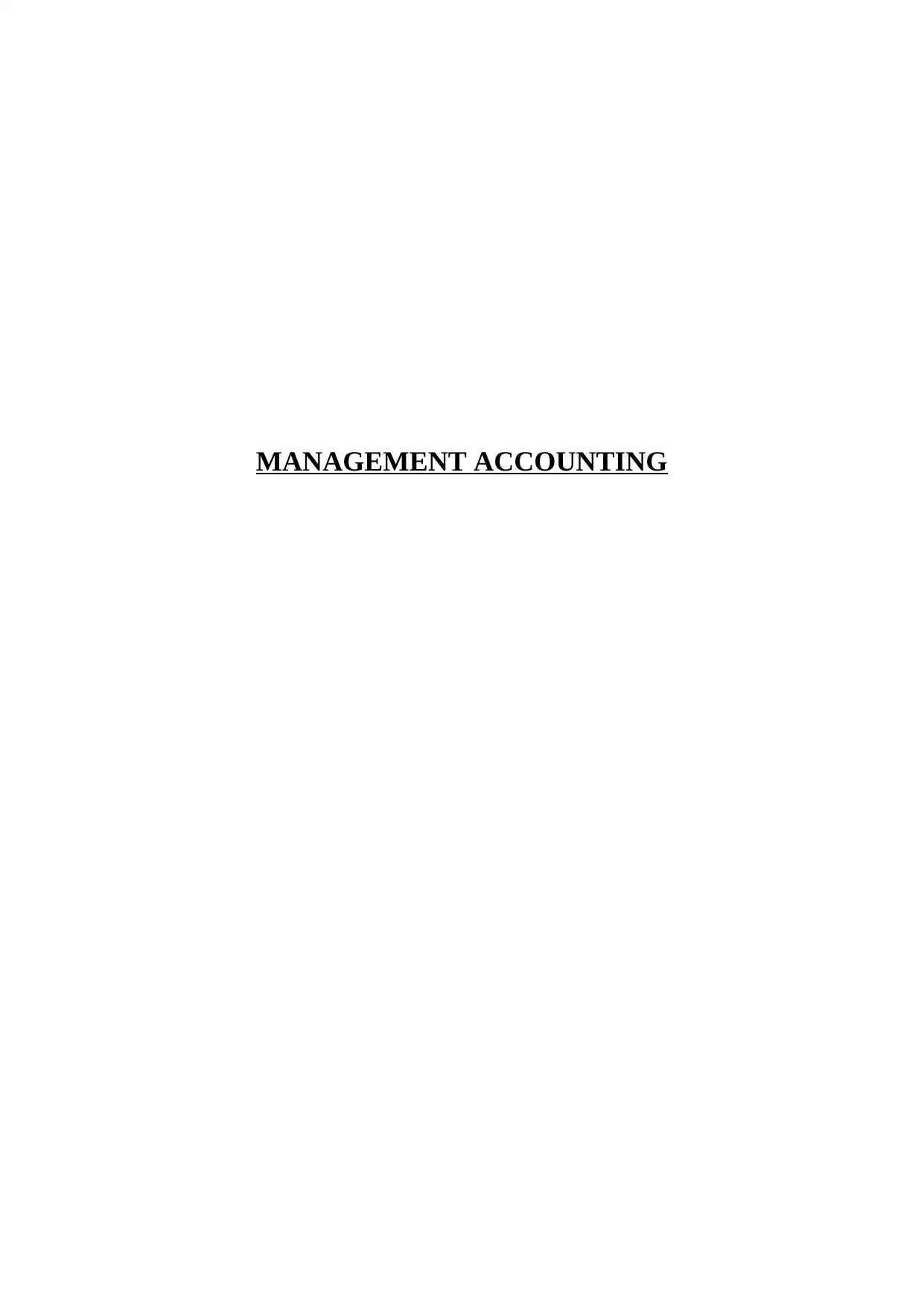
MANAGEMENT ACCOUNTING
Paraphrase This Document
Need a fresh take? Get an instant paraphrase of this document with our AI Paraphraser
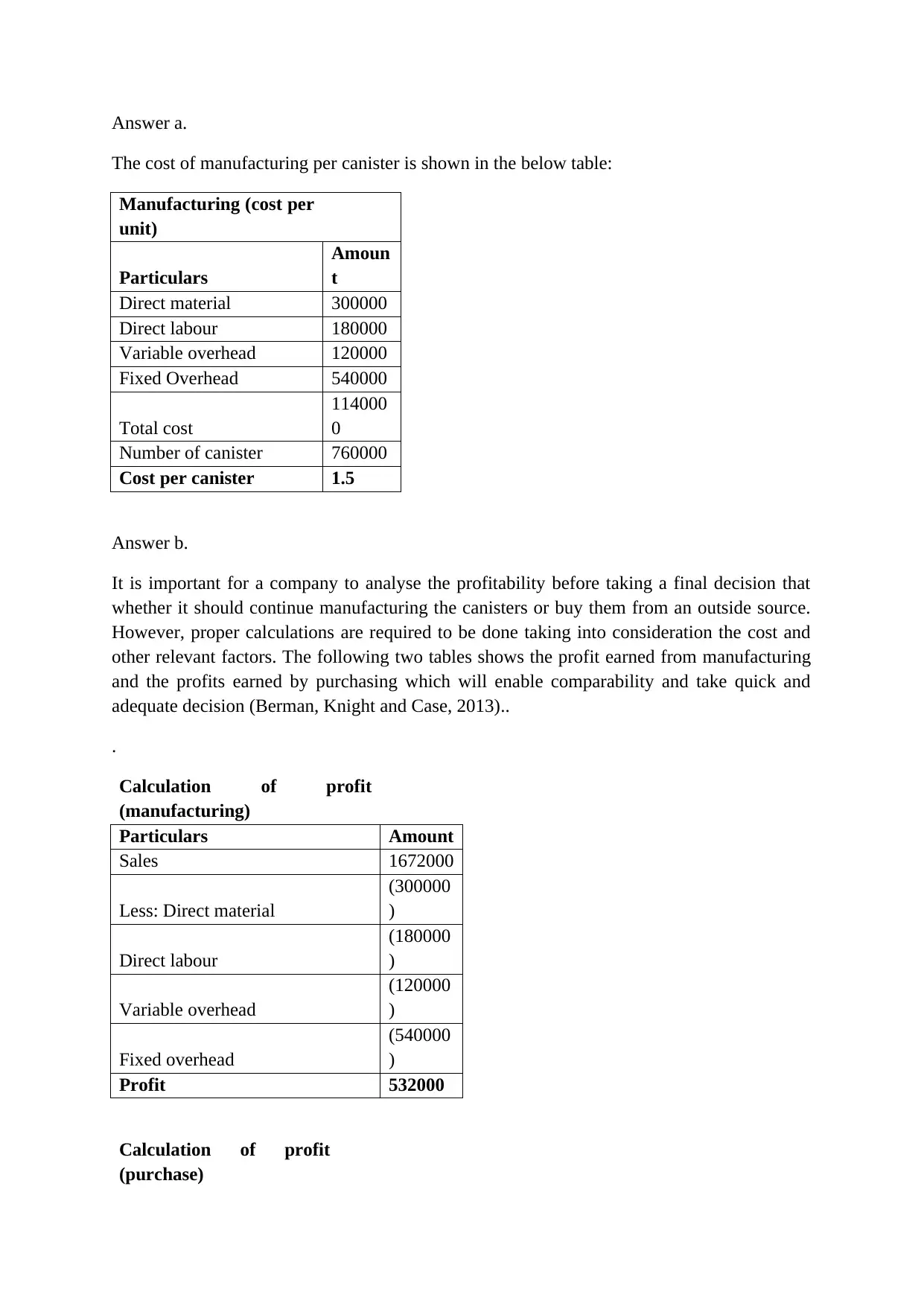
Answer a.
The cost of manufacturing per canister is shown in the below table:
Manufacturing (cost per
unit)
Particulars
Amoun
t
Direct material 300000
Direct labour 180000
Variable overhead 120000
Fixed Overhead 540000
Total cost
114000
0
Number of canister 760000
Cost per canister 1.5
Answer b.
It is important for a company to analyse the profitability before taking a final decision that
whether it should continue manufacturing the canisters or buy them from an outside source.
However, proper calculations are required to be done taking into consideration the cost and
other relevant factors. The following two tables shows the profit earned from manufacturing
and the profits earned by purchasing which will enable comparability and take quick and
adequate decision (Berman, Knight and Case, 2013)..
.
Calculation of profit
(manufacturing)
Particulars Amount
Sales 1672000
Less: Direct material
(300000
)
Direct labour
(180000
)
Variable overhead
(120000
)
Fixed overhead
(540000
)
Profit 532000
Calculation of profit
(purchase)
The cost of manufacturing per canister is shown in the below table:
Manufacturing (cost per
unit)
Particulars
Amoun
t
Direct material 300000
Direct labour 180000
Variable overhead 120000
Fixed Overhead 540000
Total cost
114000
0
Number of canister 760000
Cost per canister 1.5
Answer b.
It is important for a company to analyse the profitability before taking a final decision that
whether it should continue manufacturing the canisters or buy them from an outside source.
However, proper calculations are required to be done taking into consideration the cost and
other relevant factors. The following two tables shows the profit earned from manufacturing
and the profits earned by purchasing which will enable comparability and take quick and
adequate decision (Berman, Knight and Case, 2013)..
.
Calculation of profit
(manufacturing)
Particulars Amount
Sales 1672000
Less: Direct material
(300000
)
Direct labour
(180000
)
Variable overhead
(120000
)
Fixed overhead
(540000
)
Profit 532000
Calculation of profit
(purchase)
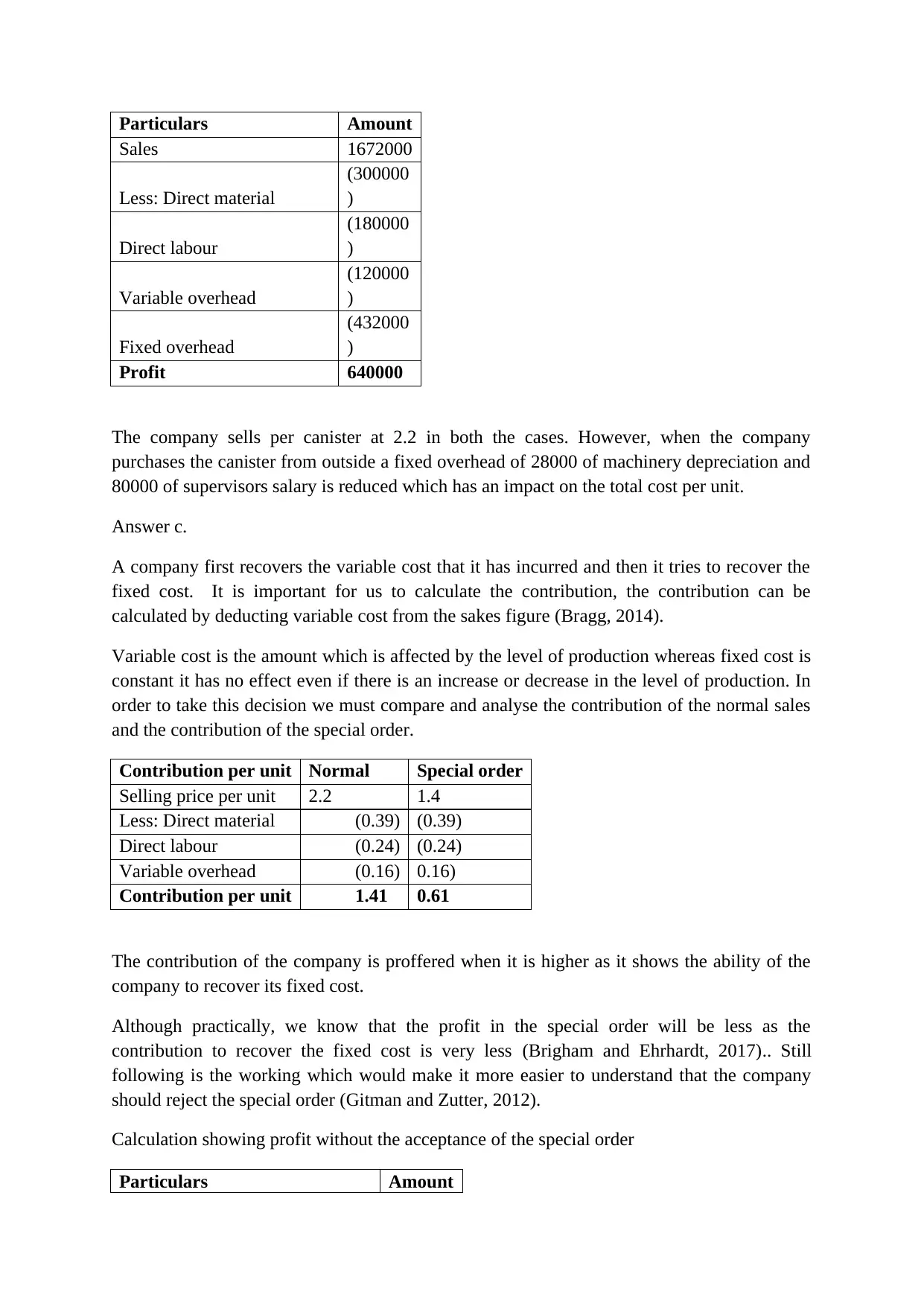
Particulars Amount
Sales 1672000
Less: Direct material
(300000
)
Direct labour
(180000
)
Variable overhead
(120000
)
Fixed overhead
(432000
)
Profit 640000
The company sells per canister at 2.2 in both the cases. However, when the company
purchases the canister from outside a fixed overhead of 28000 of machinery depreciation and
80000 of supervisors salary is reduced which has an impact on the total cost per unit.
Answer c.
A company first recovers the variable cost that it has incurred and then it tries to recover the
fixed cost. It is important for us to calculate the contribution, the contribution can be
calculated by deducting variable cost from the sakes figure (Bragg, 2014).
Variable cost is the amount which is affected by the level of production whereas fixed cost is
constant it has no effect even if there is an increase or decrease in the level of production. In
order to take this decision we must compare and analyse the contribution of the normal sales
and the contribution of the special order.
Contribution per unit Normal Special order
Selling price per unit 2.2 1.4
Less: Direct material (0.39) (0.39)
Direct labour (0.24) (0.24)
Variable overhead (0.16) 0.16)
Contribution per unit 1.41 0.61
The contribution of the company is proffered when it is higher as it shows the ability of the
company to recover its fixed cost.
Although practically, we know that the profit in the special order will be less as the
contribution to recover the fixed cost is very less (Brigham and Ehrhardt, 2017).. Still
following is the working which would make it more easier to understand that the company
should reject the special order (Gitman and Zutter, 2012).
Calculation showing profit without the acceptance of the special order
Particulars Amount
Sales 1672000
Less: Direct material
(300000
)
Direct labour
(180000
)
Variable overhead
(120000
)
Fixed overhead
(432000
)
Profit 640000
The company sells per canister at 2.2 in both the cases. However, when the company
purchases the canister from outside a fixed overhead of 28000 of machinery depreciation and
80000 of supervisors salary is reduced which has an impact on the total cost per unit.
Answer c.
A company first recovers the variable cost that it has incurred and then it tries to recover the
fixed cost. It is important for us to calculate the contribution, the contribution can be
calculated by deducting variable cost from the sakes figure (Bragg, 2014).
Variable cost is the amount which is affected by the level of production whereas fixed cost is
constant it has no effect even if there is an increase or decrease in the level of production. In
order to take this decision we must compare and analyse the contribution of the normal sales
and the contribution of the special order.
Contribution per unit Normal Special order
Selling price per unit 2.2 1.4
Less: Direct material (0.39) (0.39)
Direct labour (0.24) (0.24)
Variable overhead (0.16) 0.16)
Contribution per unit 1.41 0.61
The contribution of the company is proffered when it is higher as it shows the ability of the
company to recover its fixed cost.
Although practically, we know that the profit in the special order will be less as the
contribution to recover the fixed cost is very less (Brigham and Ehrhardt, 2017).. Still
following is the working which would make it more easier to understand that the company
should reject the special order (Gitman and Zutter, 2012).
Calculation showing profit without the acceptance of the special order
Particulars Amount
⊘ This is a preview!⊘
Do you want full access?
Subscribe today to unlock all pages.

Trusted by 1+ million students worldwide
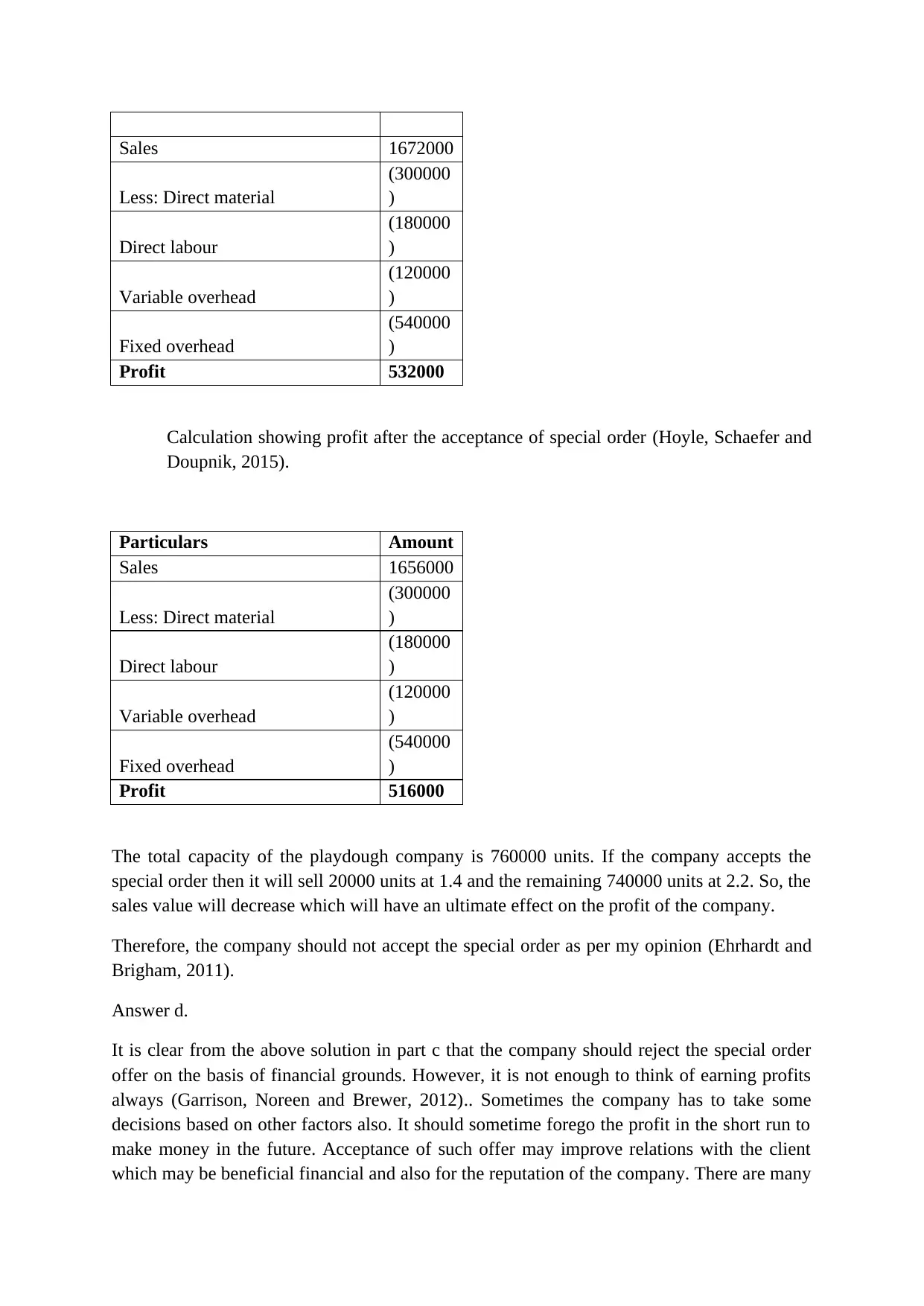
Sales 1672000
Less: Direct material
(300000
)
Direct labour
(180000
)
Variable overhead
(120000
)
Fixed overhead
(540000
)
Profit 532000
Calculation showing profit after the acceptance of special order (Hoyle, Schaefer and
Doupnik, 2015).
Particulars Amount
Sales 1656000
Less: Direct material
(300000
)
Direct labour
(180000
)
Variable overhead
(120000
)
Fixed overhead
(540000
)
Profit 516000
The total capacity of the playdough company is 760000 units. If the company accepts the
special order then it will sell 20000 units at 1.4 and the remaining 740000 units at 2.2. So, the
sales value will decrease which will have an ultimate effect on the profit of the company.
Therefore, the company should not accept the special order as per my opinion (Ehrhardt and
Brigham, 2011).
Answer d.
It is clear from the above solution in part c that the company should reject the special order
offer on the basis of financial grounds. However, it is not enough to think of earning profits
always (Garrison, Noreen and Brewer, 2012).. Sometimes the company has to take some
decisions based on other factors also. It should sometime forego the profit in the short run to
make money in the future. Acceptance of such offer may improve relations with the client
which may be beneficial financial and also for the reputation of the company. There are many
Less: Direct material
(300000
)
Direct labour
(180000
)
Variable overhead
(120000
)
Fixed overhead
(540000
)
Profit 532000
Calculation showing profit after the acceptance of special order (Hoyle, Schaefer and
Doupnik, 2015).
Particulars Amount
Sales 1656000
Less: Direct material
(300000
)
Direct labour
(180000
)
Variable overhead
(120000
)
Fixed overhead
(540000
)
Profit 516000
The total capacity of the playdough company is 760000 units. If the company accepts the
special order then it will sell 20000 units at 1.4 and the remaining 740000 units at 2.2. So, the
sales value will decrease which will have an ultimate effect on the profit of the company.
Therefore, the company should not accept the special order as per my opinion (Ehrhardt and
Brigham, 2011).
Answer d.
It is clear from the above solution in part c that the company should reject the special order
offer on the basis of financial grounds. However, it is not enough to think of earning profits
always (Garrison, Noreen and Brewer, 2012).. Sometimes the company has to take some
decisions based on other factors also. It should sometime forego the profit in the short run to
make money in the future. Acceptance of such offer may improve relations with the client
which may be beneficial financial and also for the reputation of the company. There are many
Paraphrase This Document
Need a fresh take? Get an instant paraphrase of this document with our AI Paraphraser
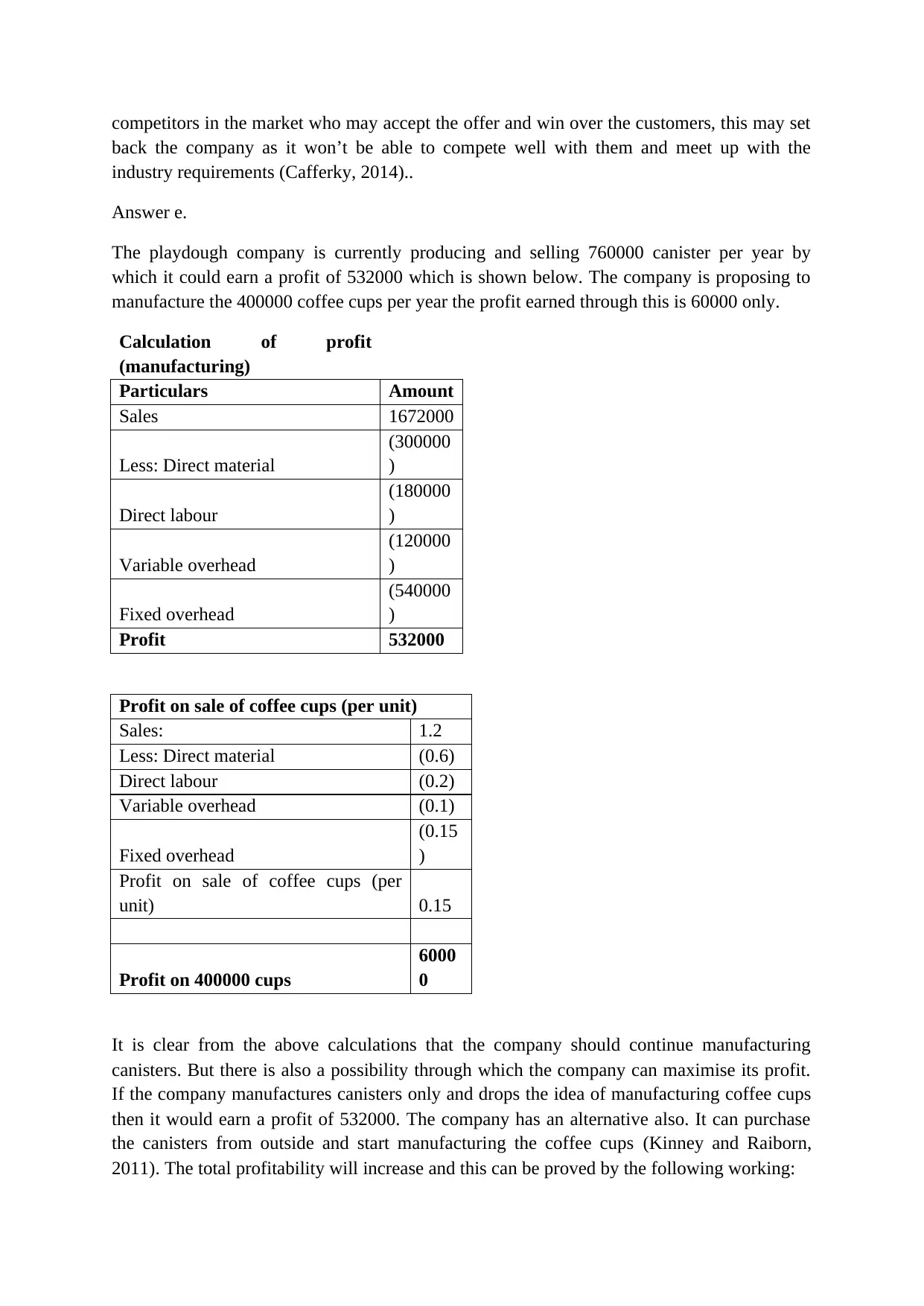
competitors in the market who may accept the offer and win over the customers, this may set
back the company as it won’t be able to compete well with them and meet up with the
industry requirements (Cafferky, 2014)..
Answer e.
The playdough company is currently producing and selling 760000 canister per year by
which it could earn a profit of 532000 which is shown below. The company is proposing to
manufacture the 400000 coffee cups per year the profit earned through this is 60000 only.
Calculation of profit
(manufacturing)
Particulars Amount
Sales 1672000
Less: Direct material
(300000
)
Direct labour
(180000
)
Variable overhead
(120000
)
Fixed overhead
(540000
)
Profit 532000
Profit on sale of coffee cups (per unit)
Sales: 1.2
Less: Direct material (0.6)
Direct labour (0.2)
Variable overhead (0.1)
Fixed overhead
(0.15
)
Profit on sale of coffee cups (per
unit) 0.15
Profit on 400000 cups
6000
0
It is clear from the above calculations that the company should continue manufacturing
canisters. But there is also a possibility through which the company can maximise its profit.
If the company manufactures canisters only and drops the idea of manufacturing coffee cups
then it would earn a profit of 532000. The company has an alternative also. It can purchase
the canisters from outside and start manufacturing the coffee cups (Kinney and Raiborn,
2011). The total profitability will increase and this can be proved by the following working:
back the company as it won’t be able to compete well with them and meet up with the
industry requirements (Cafferky, 2014)..
Answer e.
The playdough company is currently producing and selling 760000 canister per year by
which it could earn a profit of 532000 which is shown below. The company is proposing to
manufacture the 400000 coffee cups per year the profit earned through this is 60000 only.
Calculation of profit
(manufacturing)
Particulars Amount
Sales 1672000
Less: Direct material
(300000
)
Direct labour
(180000
)
Variable overhead
(120000
)
Fixed overhead
(540000
)
Profit 532000
Profit on sale of coffee cups (per unit)
Sales: 1.2
Less: Direct material (0.6)
Direct labour (0.2)
Variable overhead (0.1)
Fixed overhead
(0.15
)
Profit on sale of coffee cups (per
unit) 0.15
Profit on 400000 cups
6000
0
It is clear from the above calculations that the company should continue manufacturing
canisters. But there is also a possibility through which the company can maximise its profit.
If the company manufactures canisters only and drops the idea of manufacturing coffee cups
then it would earn a profit of 532000. The company has an alternative also. It can purchase
the canisters from outside and start manufacturing the coffee cups (Kinney and Raiborn,
2011). The total profitability will increase and this can be proved by the following working:
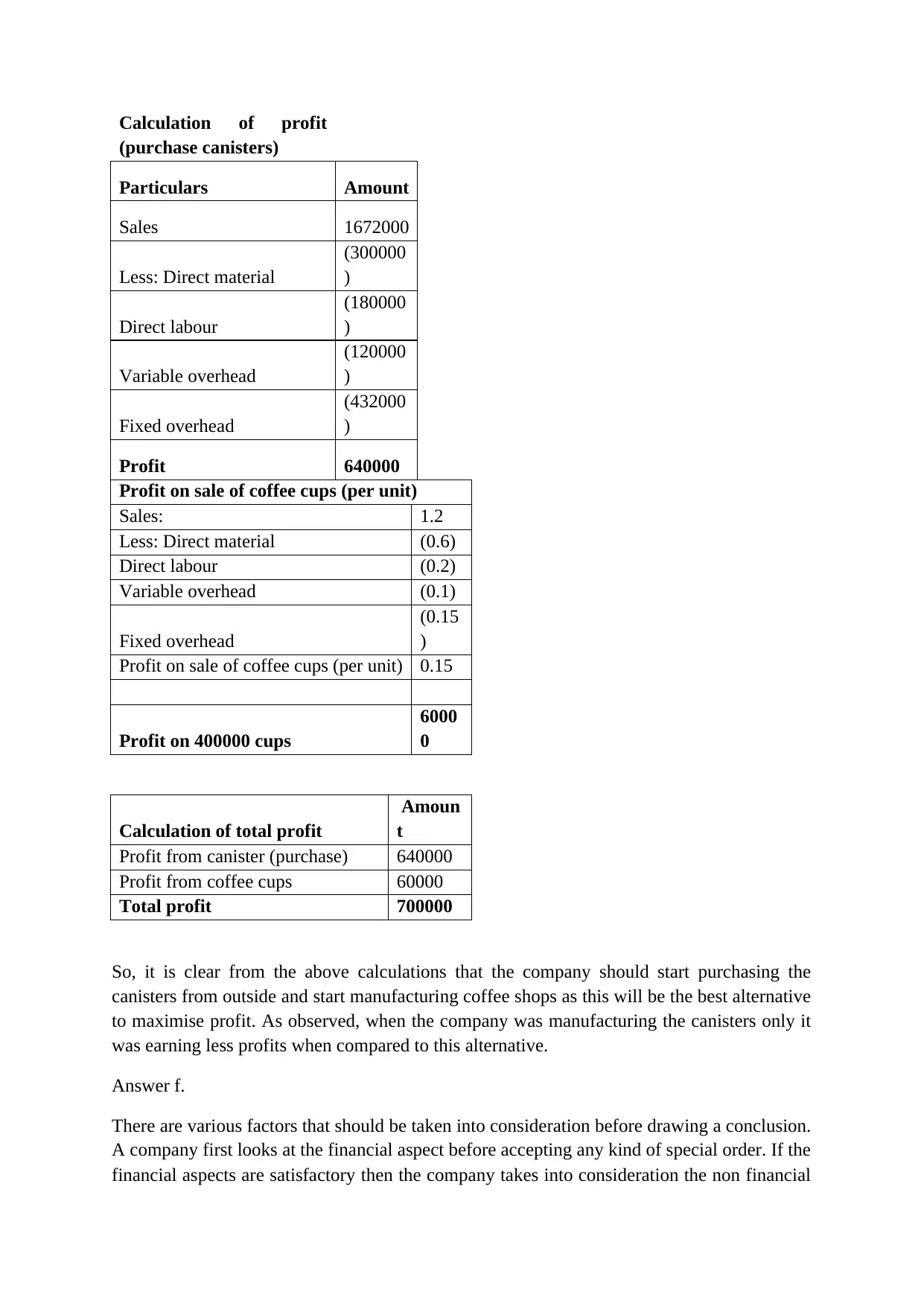
Calculation of profit
(purchase canisters)
Particulars Amount
Sales 1672000
Less: Direct material
(300000
)
Direct labour
(180000
)
Variable overhead
(120000
)
Fixed overhead
(432000
)
Profit 640000
Profit on sale of coffee cups (per unit)
Sales: 1.2
Less: Direct material (0.6)
Direct labour (0.2)
Variable overhead (0.1)
Fixed overhead
(0.15
)
Profit on sale of coffee cups (per unit) 0.15
Profit on 400000 cups
6000
0
Calculation of total profit
Amoun
t
Profit from canister (purchase) 640000
Profit from coffee cups 60000
Total profit 700000
So, it is clear from the above calculations that the company should start purchasing the
canisters from outside and start manufacturing coffee shops as this will be the best alternative
to maximise profit. As observed, when the company was manufacturing the canisters only it
was earning less profits when compared to this alternative.
Answer f.
There are various factors that should be taken into consideration before drawing a conclusion.
A company first looks at the financial aspect before accepting any kind of special order. If the
financial aspects are satisfactory then the company takes into consideration the non financial
(purchase canisters)
Particulars Amount
Sales 1672000
Less: Direct material
(300000
)
Direct labour
(180000
)
Variable overhead
(120000
)
Fixed overhead
(432000
)
Profit 640000
Profit on sale of coffee cups (per unit)
Sales: 1.2
Less: Direct material (0.6)
Direct labour (0.2)
Variable overhead (0.1)
Fixed overhead
(0.15
)
Profit on sale of coffee cups (per unit) 0.15
Profit on 400000 cups
6000
0
Calculation of total profit
Amoun
t
Profit from canister (purchase) 640000
Profit from coffee cups 60000
Total profit 700000
So, it is clear from the above calculations that the company should start purchasing the
canisters from outside and start manufacturing coffee shops as this will be the best alternative
to maximise profit. As observed, when the company was manufacturing the canisters only it
was earning less profits when compared to this alternative.
Answer f.
There are various factors that should be taken into consideration before drawing a conclusion.
A company first looks at the financial aspect before accepting any kind of special order. If the
financial aspects are satisfactory then the company takes into consideration the non financial
⊘ This is a preview!⊘
Do you want full access?
Subscribe today to unlock all pages.

Trusted by 1+ million students worldwide
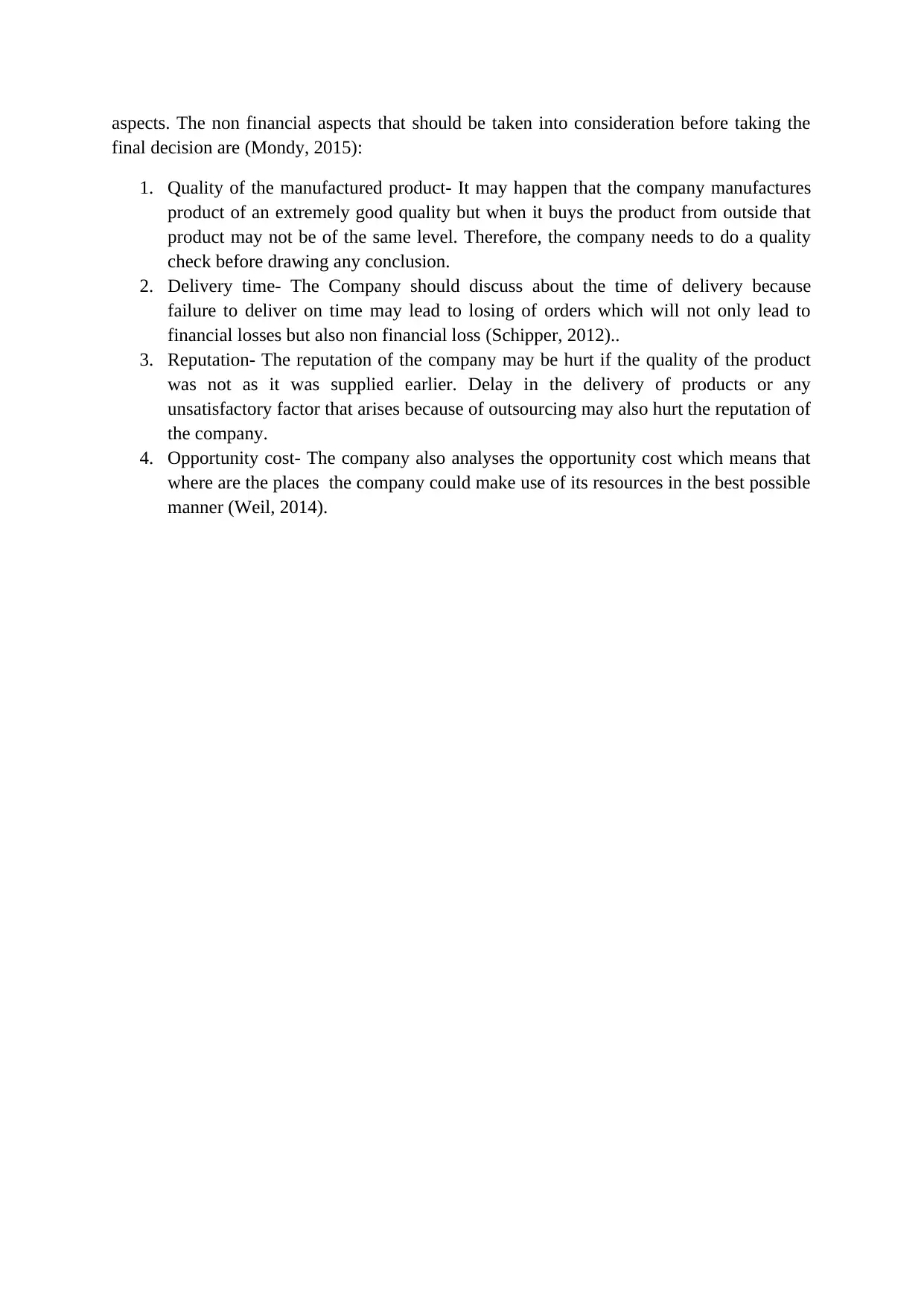
aspects. The non financial aspects that should be taken into consideration before taking the
final decision are (Mondy, 2015):
1. Quality of the manufactured product- It may happen that the company manufactures
product of an extremely good quality but when it buys the product from outside that
product may not be of the same level. Therefore, the company needs to do a quality
check before drawing any conclusion.
2. Delivery time- The Company should discuss about the time of delivery because
failure to deliver on time may lead to losing of orders which will not only lead to
financial losses but also non financial loss (Schipper, 2012)..
3. Reputation- The reputation of the company may be hurt if the quality of the product
was not as it was supplied earlier. Delay in the delivery of products or any
unsatisfactory factor that arises because of outsourcing may also hurt the reputation of
the company.
4. Opportunity cost- The company also analyses the opportunity cost which means that
where are the places the company could make use of its resources in the best possible
manner (Weil, 2014).
final decision are (Mondy, 2015):
1. Quality of the manufactured product- It may happen that the company manufactures
product of an extremely good quality but when it buys the product from outside that
product may not be of the same level. Therefore, the company needs to do a quality
check before drawing any conclusion.
2. Delivery time- The Company should discuss about the time of delivery because
failure to deliver on time may lead to losing of orders which will not only lead to
financial losses but also non financial loss (Schipper, 2012)..
3. Reputation- The reputation of the company may be hurt if the quality of the product
was not as it was supplied earlier. Delay in the delivery of products or any
unsatisfactory factor that arises because of outsourcing may also hurt the reputation of
the company.
4. Opportunity cost- The company also analyses the opportunity cost which means that
where are the places the company could make use of its resources in the best possible
manner (Weil, 2014).
Paraphrase This Document
Need a fresh take? Get an instant paraphrase of this document with our AI Paraphraser
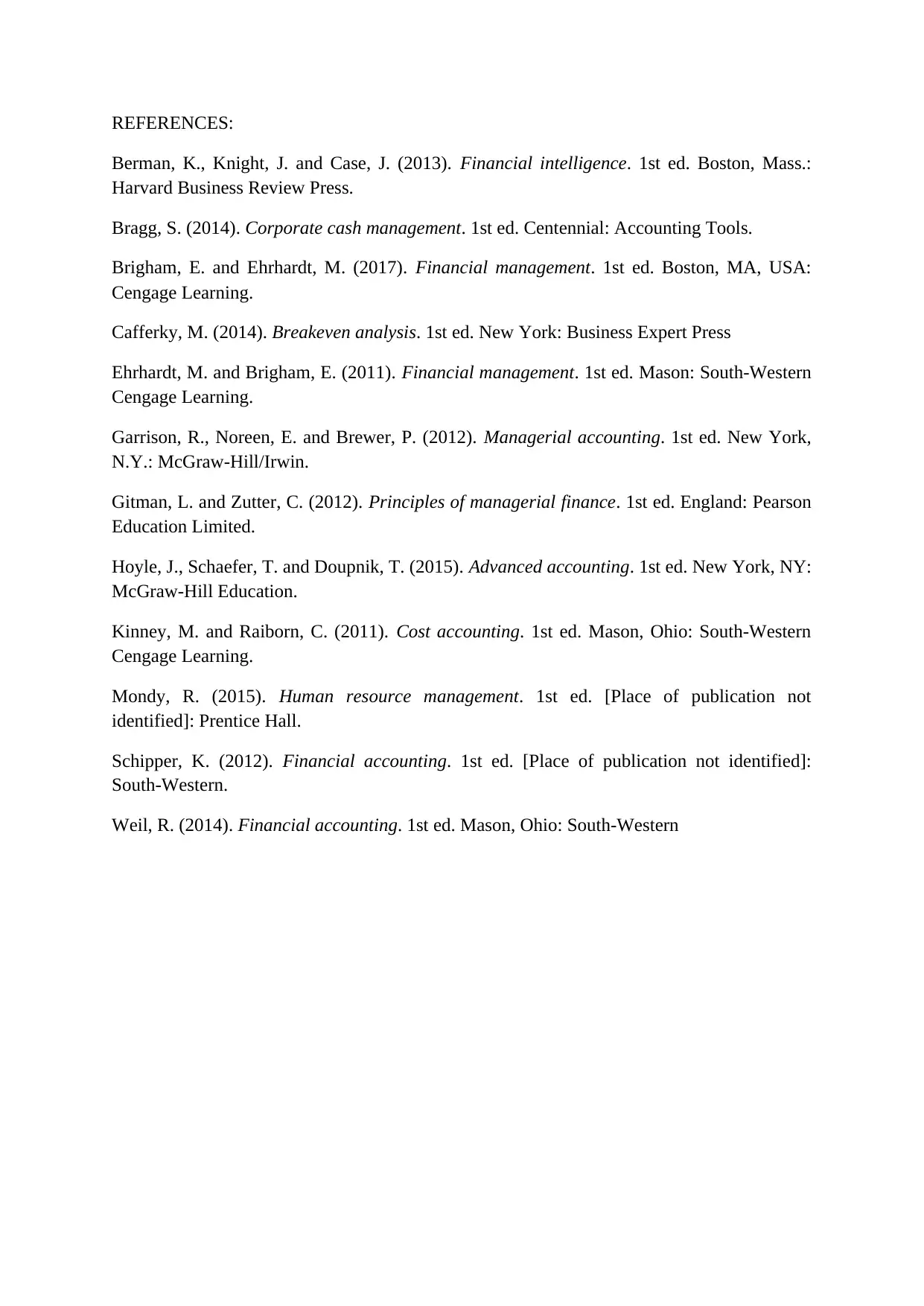
REFERENCES:
Berman, K., Knight, J. and Case, J. (2013). Financial intelligence. 1st ed. Boston, Mass.:
Harvard Business Review Press.
Bragg, S. (2014). Corporate cash management. 1st ed. Centennial: Accounting Tools.
Brigham, E. and Ehrhardt, M. (2017). Financial management. 1st ed. Boston, MA, USA:
Cengage Learning.
Cafferky, M. (2014). Breakeven analysis. 1st ed. New York: Business Expert Press
Ehrhardt, M. and Brigham, E. (2011). Financial management. 1st ed. Mason: South-Western
Cengage Learning.
Garrison, R., Noreen, E. and Brewer, P. (2012). Managerial accounting. 1st ed. New York,
N.Y.: McGraw-Hill/Irwin.
Gitman, L. and Zutter, C. (2012). Principles of managerial finance. 1st ed. England: Pearson
Education Limited.
Hoyle, J., Schaefer, T. and Doupnik, T. (2015). Advanced accounting. 1st ed. New York, NY:
McGraw-Hill Education.
Kinney, M. and Raiborn, C. (2011). Cost accounting. 1st ed. Mason, Ohio: South-Western
Cengage Learning.
Mondy, R. (2015). Human resource management. 1st ed. [Place of publication not
identified]: Prentice Hall.
Schipper, K. (2012). Financial accounting. 1st ed. [Place of publication not identified]:
South-Western.
Weil, R. (2014). Financial accounting. 1st ed. Mason, Ohio: South-Western
Berman, K., Knight, J. and Case, J. (2013). Financial intelligence. 1st ed. Boston, Mass.:
Harvard Business Review Press.
Bragg, S. (2014). Corporate cash management. 1st ed. Centennial: Accounting Tools.
Brigham, E. and Ehrhardt, M. (2017). Financial management. 1st ed. Boston, MA, USA:
Cengage Learning.
Cafferky, M. (2014). Breakeven analysis. 1st ed. New York: Business Expert Press
Ehrhardt, M. and Brigham, E. (2011). Financial management. 1st ed. Mason: South-Western
Cengage Learning.
Garrison, R., Noreen, E. and Brewer, P. (2012). Managerial accounting. 1st ed. New York,
N.Y.: McGraw-Hill/Irwin.
Gitman, L. and Zutter, C. (2012). Principles of managerial finance. 1st ed. England: Pearson
Education Limited.
Hoyle, J., Schaefer, T. and Doupnik, T. (2015). Advanced accounting. 1st ed. New York, NY:
McGraw-Hill Education.
Kinney, M. and Raiborn, C. (2011). Cost accounting. 1st ed. Mason, Ohio: South-Western
Cengage Learning.
Mondy, R. (2015). Human resource management. 1st ed. [Place of publication not
identified]: Prentice Hall.
Schipper, K. (2012). Financial accounting. 1st ed. [Place of publication not identified]:
South-Western.
Weil, R. (2014). Financial accounting. 1st ed. Mason, Ohio: South-Western
1 out of 8
Related Documents
Your All-in-One AI-Powered Toolkit for Academic Success.
+13062052269
info@desklib.com
Available 24*7 on WhatsApp / Email
![[object Object]](/_next/static/media/star-bottom.7253800d.svg)
Unlock your academic potential
Copyright © 2020–2025 A2Z Services. All Rights Reserved. Developed and managed by ZUCOL.





